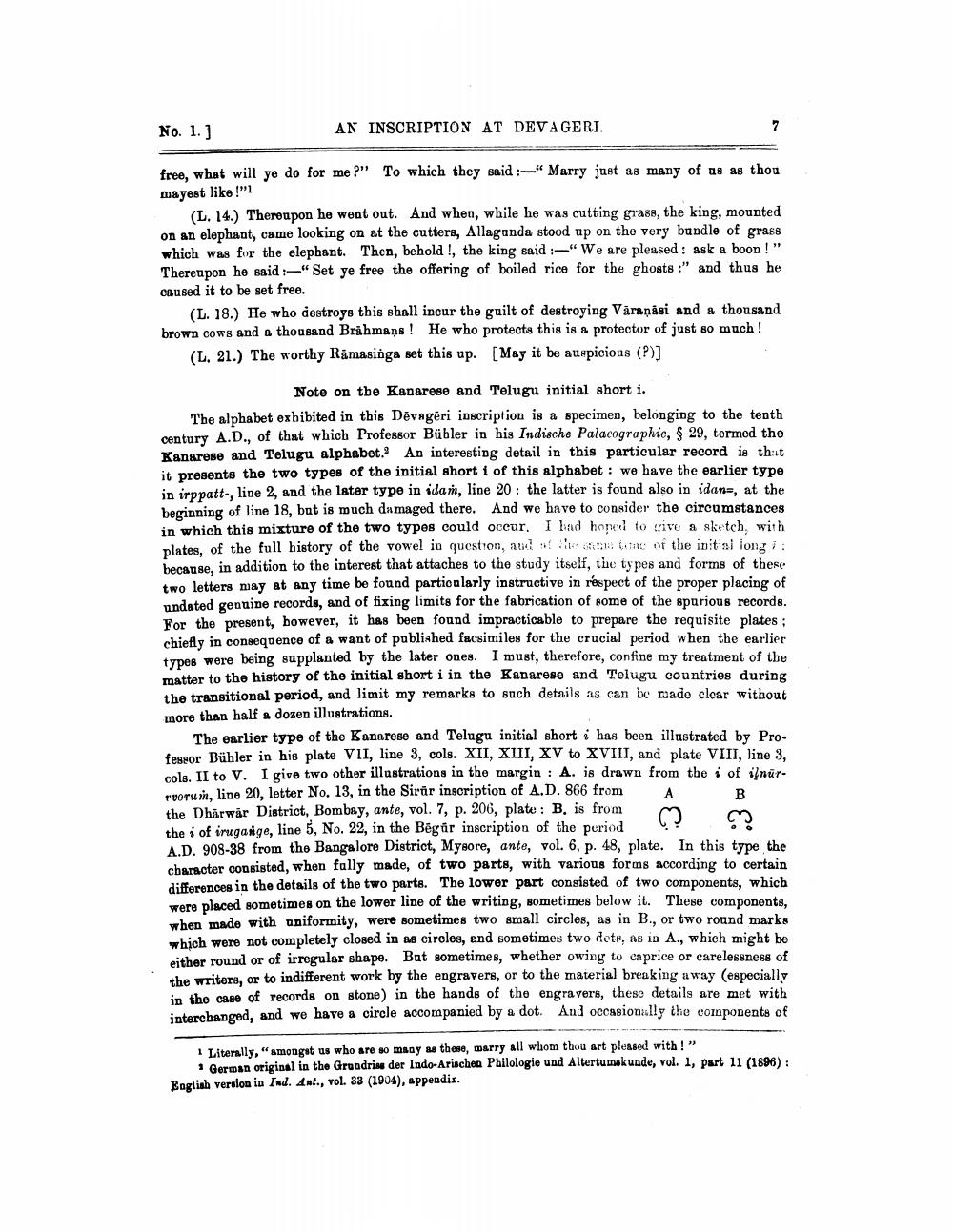________________
No. 1.]
AN INSCRIPTION AT DEVAGERI.
free, what will ye do for me?" To which they said :-"Marry just as many of as as thou mayest like !"
(L. 14.) Thereupon he went out. And when, while he was cutting grass, the king, mounted on an elephant, came looking on at the cutters, Allaganda stood up on the very bandle of grass which was for the elephant. Then, behold !, the king said :-"We are pleased : ask a boon!" Thereupon he said :-"Set ye free the offering of boiled rice for the ghosts :" and thus he caused it to be set free.
(L. 18.) He who destroys this shall incur the guilt of destroying Varanasi and a thousand brown cows and a thousand Brahmans! He who protects this is a protector of just so much!
(L. 21.) The worthy Råmasinga set this up. [May it be auspicious (P)]
Note on the Kanarese and Telugu initial short i. The alphabet exbibited in this Dēvagēri inscription is a specimen, belonging to the tenth century A.D., of that which Professor Bübler in his Indische Palaeographie, $ 29, termed the Kanarese and Telugu alphabet. An interesting detail in this particular record is that it presents the two types of the initial short i of this alphabet : we have the earlier type in irppatt-, line 2, and the later type in idar, line 20 : the latter is found also in idans, at the beginning of line 18, but is much damaged there. And we have to consider the circumstances in which this mixture of the two types could occur. I had hoped to rive a sketch, with plates, of the full history of the vowel in question, au
Dans of the initial longi: because, in addition to the interest that attaches to the study itself, the types and forms of there two letters may at any time be found particularly instructive in respect of the proper placing of undated genuine records, and of fixing limits for the fabrication of some of the sparious records. For the present, however, it has been found impracticable to prepare the requisite plates ; chiefly in consequence of a want of published facsimiles for the crucial period when the earlier types were being supplanted by the later ones. I must, therefore, confine my treatment of the matter to the history of the initial short i in the Kanarese and Telugu countries during the transitional period, and limit my remarks to such details as can be mado clear without more than half a dozen illustrations.
The earlier type of the Kanarese and Telugu initial short i has been illustrated by Professor Bühler in his plate VII, line 3, cols. XII, XIII, XV to XVIIT, and plate VIII, line 3, cols. II to V. I give two other illustrations in the margin: A. is drawn from the i of inarruorum, line 20, letter No. 13, in the Sirar inscription of A.D. 866 from A
B the Dhirwar District, Bombay, ante, vol. 7, p. 206, platu: B. is from the i of irugarige, line 5, No. 22, in the Begar inscription of the period ? SP A.D. 908-38 from the Bangalore District, Mysore, ante, vol. 6, p. 48, plate. In this type the character consisted, when fally made, of two parts, with various forms according to certain differences in the details of the two parts. The lower part consisted of two components, which were placed sometimes on the lower line of the writing, sometimes below it. These components. when made with uniformity, were sometimes two small circles, as in B., or two round marks which were not completely closed in a circles, and sometimes two detr, as ia A., which might be either round or of irregular shape. But sometimes, whether owing to caprice or carelessness of the writers, or to indifferent work by the engravers, or to the material breaking away (especially in the case of records on stone) in the hands of the engravers, these details are met with interchanged, and we have a circle accompanied by a dot. And occasionally the components of
Literally,"amongst us who are so many as these, marry all whom thou art pleased with!”
1 German original in the Grundriss der Indo-Arischen Philologie und Altertumskunde, vol. 1, part 11 (1896): English version in Ind. Ant., vol. 33 (1904), appendis.




